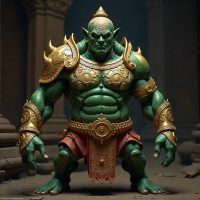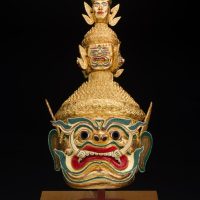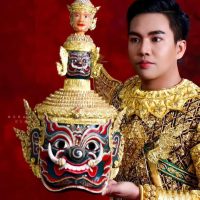Krong Reap : Demon King of the Reamker
Listen
At a glance
| Description | |
|---|---|
| Origin | Cambodian Mythology |
| Classification | Demigods |
| Family Members | Sovanna Maccha (Sister), Mandodari (WIfe) |
| Region | Cambodia |
| Associated With | Royalty, Strength, Magic, Shapeshifting |
Krong Reap
Introduction
Krong Reap stands as one of the most compelling antagonists in Cambodian mythology, dominating the narrative of the Reamker, the Khmer adaptation of the Ramayana. While he originates from the Indian figure Ravana, his portrayal in the Reamker reflects uniquely Cambodian cultural, spiritual, and artistic interpretations. As ruler of Lanka and master of dark sorcery, Krong Reap’s actions—most notably the abduction of Neang Seda—set the stage for the grand conflict between him and the hero Preah Ream. Through him, the Reamker explores themes central to Khmer philosophy: the balance of power, moral duty, spiritual consequence, and the destructive nature of unchecked desire. Krong Reap’s character reinforces the timeless tension between righteousness and malevolence, shaping a narrative that continues to influence Cambodian identity.
Physical Traits
Krong Reap’s appearance is designed to embody fear, authority, and otherworldly power. Traditional Cambodian art often describes him as a giant demon-king with multiple heads—commonly ten—and numerous arms, each representing his extraordinary strength and supernatural origins. His skin is frequently portrayed in dark tones, echoing his association with demonic realms and sorcery. Elaborate golden armor, towering crowns, and ornamented garments signal his royal status and emphasize his command over Lanka. His fangs, sharp gaze, and immense stature convey a presence both regal and terrifying, distinguishing him sharply from the serene, righteous image of Preah Ream. These quintessential traits have become iconic within Khmer dance, theatre, sculpture, and mural traditions, making Krong Reap instantly recognizable across Cambodia.
Family
Krong Reap’s lineage weaves together divine heritage and demonic ancestry, giving him a complex identity. In the Reamker, he is the brother of Surpanakha, whose encounter with Preah Ream and Preah Leak triggers the chain of events that lead to the epic war. His wife, Mandodari, is known for her wisdom and loyalty, often portrayed as a stabilizing force whose counsel Krong Reap tragically ignores. His children, including the formidable warrior Indrajit, play pivotal roles in defending Lanka against Preah Ream’s advancing forces. While Krong Reap is depicted as a tyrant, his devotion to his family and subjects adds emotional depth to his character, illustrating the duality of a ruler torn between responsibility and unchecked ambition. These relational ties enrich the narrative and highlight how personal choices can ripple into cosmic conflict.
Other names
Though most widely known in Cambodia as Krong Reap, the demon king is recognized by several related names across Southeast Asian traditions. His Sanskrit name Ravana remains the most universally known, linking him to the broader Ramayana legacy. In Khmer oral storytelling, shorter variations such as Reap or Riep also appear. Historical French colonial texts sometimes transliterated his title as Krong Riep, emphasizing his status as sovereign of Lanka. These linguistic variations showcase the cultural blending that shaped the Reamker, preserving Indian roots while allowing Khmer storytellers to mold the character into a figure aligned with local ethics, religious values, and artistic norms.
Powers and Abilities
Krong Reap’s fearsome reputation stems largely from his extraordinary powers. He possesses immense physical strength that matches his colossal form, enabling him to overpower gods, demons, and mortals alike. His mastery of magic includes shape-shifting, illusions, enchantments, and the ability to traverse realms through flight. Central to his near invincibility is a divine boon earned through severe ascetic practices, granting him protection from most weapons and supernatural forces. Though endowed with brilliance and strategic insight, he relies heavily on armies of rakshasas, sorcerers, and mythical beings to wage war. His downfall, despite his unparalleled abilities, stems from moral flaws—arrogance, desire, and the refusal to accept wise counsel—reflecting the Buddhist and Hindu teachings embedded in the Khmer epic.
Modern Day Influence
Krong Reap remains deeply woven into Cambodian cultural life. Performances of the Royal Ballet of Cambodia and Lakhon Khol continue to dramatize his battles, preserving centuries-old choreography and ornate mask traditions. Temple murals such as those in the Silver Pagoda and at Angkor Wat depict scenes from the Reamker, including Krong Reap’s confrontations with Preah Ream, showcasing his enduring artistic presence. Shadow puppetry, or Sbek Thom, brings his character to life through detailed leather carvings that echo ancient storytelling rituals recognized by UNESCO.
In modern Cambodia, Krong Reap also appears in children’s books, graphic novels, and animated retellings that reinterpret him as both villain and tragic figure. His struggles are used in educational settings to explore ideas of compassion, pride, and ethical leadership. Through ritual, performance, and contemporary media, Krong Reap continues to symbolize the dangers of unchecked ego while remaining one of the most captivating figures in Southeast Asian mythology.
Related Images
Source
Cambodian Community Day. (2015, September 4). The Khmer Reamker overview. Retrieved November 15, 2025, from https://cambodiancommunityday.org/the-khmer-reamker-overview
Wonders of Cambodia. (2025, September 21). The Reamker: Cambodia’s Epic of Good and Evil. Retrieved November 15, 2025, from https://wondersofcambodia.com/the-reamker-cambodias-epic-of-good-and-evil
CID-DS. Reamker: Version of Ramayana in Cambodia. Retrieved November 15, 2025, from https://cid-ds.org/reamker-version-of-ramayana-in-cambodia
MOWCAP. Summary of restored files on Cambodian mythology. Retrieved November 15, 2025, from https://mowcapunesco.org/restored-files-cambodian-mythology
Academia.edu. (2020, December 31). Supernatural Ancestors of the Cambodian People. Retrieved November 15, 2025, from https://www.academia.edu/12345678/supernatural-ancestors-cambodian-people
Horizon Journal of Humanities and Social Sciences Research. Retrieved November 15, 2025, from https://horizon-jhssr.com/article/reamker-cultural-impact
Bizot, F. (1994). Le figuier à cinq branches: Réflexion sur le bouddhisme khmer. Éditions du Seuil.
Pou, S. (1982). Reamker: L’épopée khmère. École française d’Extrême-Orient.
Frequently Asked Questions
Who is Krong Reap in Cambodian mythology?
Krong Reap is the demon king and main antagonist of the Reamker, Cambodia’s adaptation of the Ramayana.
Is Krong Reap the same as Ravana?
Yes, Krong Reap is the Khmer interpretation of Ravana, though adapted with unique local cultural and spiritual elements.
Why did Krong Reap abduct Neang Seda?
His abduction of Neang Seda stems from desire and vengeance, triggering the epic war with Preah Ream.
What powers does Krong Reap possess?
He wields immense strength, dark magic, shape-shifting, and near-invulnerability granted by divine boons.
How is Krong Reap represented in Khmer culture today?
He appears prominently in classical dance, temple murals, shadow puppetry, literature, and modern reinterpretations.










